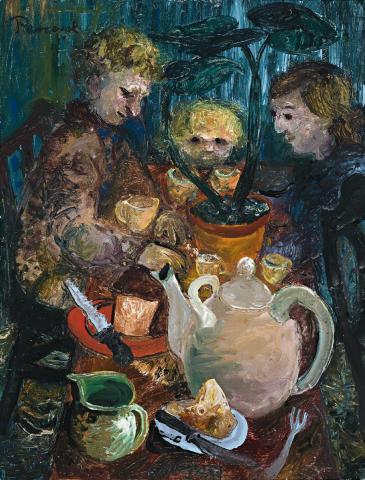THE FAMILY (BREAKFAST WITH NEIL DOUGLAS), 1959
John Perceval
oil on composition board
61.0 x 46.0 cm
signed upper left: Perceval, inscribed verso: Family … JP Oct 70 / for duration onl / of S.Y.G Exhibition / 23rd / Oct / ‘70
South Yarra Gallery, Melbourne (label attached verso)
Private collection, Melbourne
Deutscher~Menzies, Sydney, 5 December 2007, lot 20
Private collection, Melbourne
Recent Works by John Perceval, South Yarra Gallery, Melbourne, October 1970 (inscribed verso)
Plant, M., John Perceval, Lansdowne Australian Art Library, Melbourne, 1971, pp. 80–83 (illus.)
Allen, T., John Perceval, Melbourne University Press, Melbourne, 1992, p. 160
The romantic expressionism that marks John Perceval's career holds an enduring and deeply admired place in modern Melbourne painting. His connection with Heide's John and Sunday Reed and artists such as Nolan, Tucker, Hester and Arthur Boyd offered him an empathetic environment in which he flourished. He exhibited in the now legendary Antipodean Exhibition in 1959 which was organised in response to the rising interest in international abstraction, especially American.1 But Perceval and his circle were not reactionaries; he was, after all, an Angry Penguin and his gritty work from the 1940s is memorable for its intense and surreal images of the urban environment.2
But these eventually gave way to more lyrical, personal and introspective subjects. There were portraits, biblical narratives cast in the Australian landscape and, by the end of the fifties, his exuberant vision of the Melbourne docks. At Murrumbeena in 1944, Perceval and Boyd established Arthur Merric Boyd Pottery, initially engaged in the production of utilitarian pottery. Perceval had met Arthur Boyd during the War and before it ended, he had married Boyd's sister, Mary.
Dating from this period, The Family, 1959, captures two elements which were important to the artist: a sense of family and Murrumbeena. Perceval had an unhappy childhood - parental conflict and separation, and he himself had suffered from polio. The time spent at Murrumbeena was an immensely productive one and his ceramics of Angels are exemplars of Australian pottery of the 1950s.
The Family 1959 is an intimate painting, warm and unassuming. Looking at the work, one cannot but be reminded of Perceval's biblical-inspired earlier works; it is like a rustic nativity of comfort and reassurance. It is gentle, lyrical and loving and the pottery in the foreground is possibly his, or that of artist and Murrumbeena pottery decorator, Neil Douglas (1911 - 2003) who is included in the subject. Out of a deep, rich background the figures radiate a charm and innocence: an image of an idealised childhood that the artist himself never had.
1. Art historian Bernard Smith wrote the manifesto for the Antipodean Exhibition and other exhibitors included Charles Blackman, Arthur Boyd, David Boyd, John Brack, Robert Dickerson and Clifton Pugh.
2. The Angry Penguins were a coterie of like-minded artists and writers and artists who gathered under the banner of Max Harris's magazine of the same name. Despite its impressive avant-garde credentials it continues to be remembered by the Ern Malley hoax.
